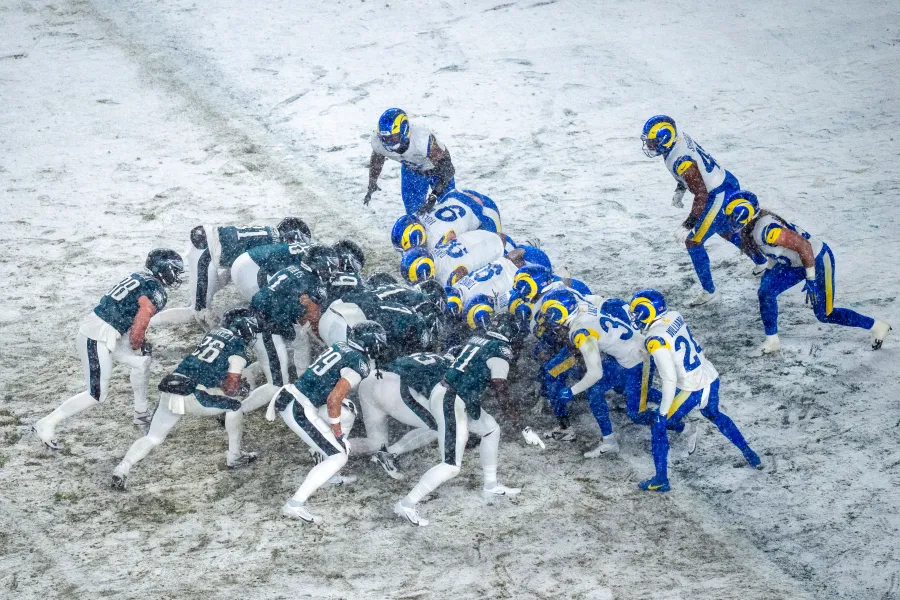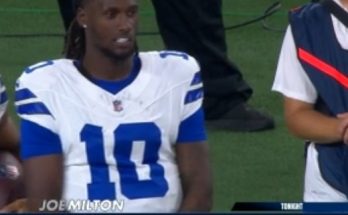The “tush push” is one of the most controversial plays in the NFL today. Also known as the quarterback sneak, it involves a quarterback being pushed by teammates from behind while attempting to move the ball a short distance, typically on a fourth-and-1 or a third-and-1 play. While this strategy has gained popularity in recent years, particularly with teams like the Philadelphia Eagles, it has sparked intense debate among coaches, players, fans, and even league officials. At the heart of the debate lies a question: should the NFL allow the play to continue or ban it for the safety of the players and the integrity of the game?
The Emergence of the Tush Push
The tush push, a term that has become synonymous with the Eagles’ success, was not invented by Philadelphia. It’s been a part of football since its early days. However, the way the Eagles have employed it, especially in recent seasons, has drawn more attention to it.
In essence, the play works as follows: the quarterback lines up under center and takes the snap as he normally would during a quarterback sneak. But instead of simply trying to barrel forward on his own, teammates, most notably the offensive line and sometimes a fullback or tight end, line up behind the quarterback and push him forward as he tries to gain those precious few yards. This strategy has been highly effective for the Eagles, especially with quarterback Jalen Hurts, who is known for his strength and mobility.
The play gained significant media attention during the 2022 and 2023 seasons when the Eagles used it to great effect. They converted an impressive number of third- and fourth-down situations using the tush push, making it a staple of their offensive playbook. But while the Eagles found success with it, other teams started to see its potential, and the NFL’s governing bodies began to examine whether the play should be allowed to continue in its current form.
The Legal Debate: Is It Legal or Not?
The controversy surrounding the tush push is not just about its effectiveness, but also about whether it is a legal play under the NFL’s current rulebook. Traditionally, the NFL has prohibited players from pushing a ball carrier from behind. This is because it goes against the spirit of the game, which is designed to reward individual effort. The rule is intended to prevent a situation where an offensive player is aided too much by teammates.
However, the NFL has never been clear-cut about this rule in practice. While pushing from behind is generally illegal, the league has never explicitly banned the practice when it comes to quarterback sneaks. Some analysts believe that the league simply overlooked the possibility of a play like the tush push, which involves the entire offensive line participating in the push, rather than just a single player. The question is whether this play violates the intent of the “no pushing from behind” rule or if it represents a legitimate evolution of the game.
What has made the situation even more confusing is the NFL’s inconsistency in enforcing the rule. In some instances, plays that involve a quarterback sneak and pushing from behind have been flagged, while in others, the same scenario goes unpenalized. This lack of consistency has fueled arguments for and against the tush push.
In response to the growing controversy, the NFL Competition Committee began evaluating the legality of the tush push. Coaches like Nick Sirianni, head coach of the Eagles, argue that the play is a legitimate part of the game and that it follows the rules as they are currently written. Sirianni and other proponents of the play suggest that pushing from behind is part of football’s physical nature and that the rule against it was never meant to apply to a quarterback sneak, which is a time-honored play that has been part of the sport for decades.
On the other side of the argument, critics of the tush push argue that the play is essentially an unfair advantage. The biggest concern is that it changes the dynamic of short-yardage situations, making them almost impossible to defend against. The NFL, which prides itself on parity and competitive balance, is wary of allowing one team or strategy to dominate the league, especially in such a straightforward and seemingly unstoppable situation. If a team can reliably convert every fourth-and-1 with the tush push, it could fundamentally alter the balance of power between teams.
The Safety Argument
Another major point of contention is the safety of the play. Critics of the tush push argue that it puts players at unnecessary risk. While quarterback sneaks have always involved some level of contact and risk, the tush push increases that risk because it involves multiple players converging on the quarterback. The quarterback, often the focal point of a team’s offense, is especially vulnerable in these situations.
While the offensive line pushes from behind, defenders are naturally going to fight to stop the play, often leading to a pileup of players at the line of scrimmage. This increases the likelihood of collisions and injuries. Quarterbacks, who are typically less accustomed to taking hits in such close proximity to the line, could be exposed to more serious injuries as a result. In particular, neck, back, and leg injuries could become more common if players are consistently being pushed and stacked in this manner.
In addition, defensive players are also at risk. The pileups created by tush push plays can lead to inadvertent hits that result in injuries to both the offensive and defensive players involved. Because of the sheer number of players involved in these situations, the risk of collisions becomes more dangerous, and the potential for injuries to multiply increases.
There have been concerns raised about whether the play could result in more serious injuries to quarterbacks and defenders alike. For instance, a defender who tries to tackle a quarterback being pushed forward might suffer a high-impact collision with one of his teammates or with the quarterback, which could lead to neck and head injuries. These concerns are particularly important given the NFL’s recent efforts to make the game safer by cracking down on hits to the head and other types of dangerous collisions.
The Strategic Advantage
Proponents of the tush push, such as Eagles head coach Nick Sirianni and quarterback Jalen Hurts, argue that the play is simply another example of strategic evolution in the game of football. The NFL has always been a league that adapts to new strategies, and the tush push is just the latest in a long line of innovations that have shaped the way the game is played.
For the Eagles, the tush push has been a particularly effective strategy. The team’s offensive line, one of the best in the NFL, is known for its ability to dominate at the line of scrimmage. With a powerful quarterback like Hurts, who is built like a running back, the tush push has been virtually unstoppable on short-yardage plays. The Eagles’ success with the play has led to it becoming one of the most feared tactics in the league.
Other teams have attempted to replicate the Eagles’ success with the tush push, but many have found that it’s not as easy as it seems. While the concept is simple, executing it at a high level requires an exceptional offensive line, a powerful and mobile quarterback, and precise timing. Teams that lack these elements may struggle to make the play work as effectively as the Eagles have.
Despite the Eagles’ dominance with the tush push, other teams have been critical of the play. Some argue that the play is essentially a form of “gamebreaking” that undermines the competitive integrity of the NFL. In a sport built on strategic innovation, the tush push represents a relatively simple tactic that is incredibly effective, leading some to question whether it’s fair for one team to dominate a fundamental aspect of the game with this play.
The NFL’s Response and Future of the Tush Push
The NFL’s Competition Committee is likely to continue evaluating the tush push in the coming seasons. Given the growing popularity of the play and its increasing importance in the league, it seems likely that the NFL will either introduce new rules to limit the play’s effectiveness or potentially ban it altogether. Some have suggested that the NFL could implement a rule similar to what the NCAA uses, which bans pushing from behind altogether.
Others believe the NFL might decide to regulate the use of the tush push by imposing certain restrictions. For example, they could allow the play but limit the number of players who can push from behind or restrict the conditions under which it can be executed. While the NFL has yet to make any definitive decisions on the matter, it’s clear that the tush push has sparked a larger conversation about how the game of football should evolve in the future.



